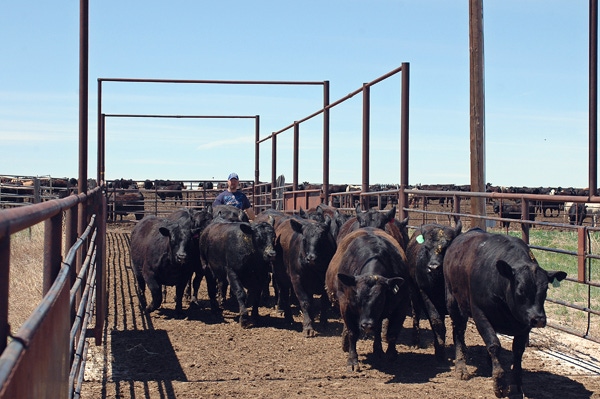Cattle futures chase calf and feeder prices lower
Auction receipts were lighter this week, with Labor day and with sellers using ample grass to delay marketing amid current volatility and faltering prices.
September 12, 2015

Notwithstanding a surge in cattle futures on Tuesday, cash calf and feeder cattle prices mustered steady money at best this week, as futures prices hovered and then crumbled again on Friday.
“The market continues to be very uneven, responding to the CME, the stock market and global market conditions. Feedlot margins and closeouts continue to be negative, causing buyers to be cautious,” explains Ed Czerwien, USDA market news reporter, in his BEEF Cattle Market Wrap-up.
On the other side of the fence, Czerwien explains, “Ample grass is allowing buyers to wait and see how the market will progress.”
Analysts with the Agricultural Marketing Service (AMS) echo that sentiment. “It has been hard to find price-friendly news for the cattle complex,” they say. “The strong pressure working through cattle futures and cash prices over the last several weeks has many cattle buyers pausing and taking a wait-and-see approach.”
Between the holiday-shortened week and buyer reluctance, auction receipts were lighter this week.

18 photos show ranchers hard at work on the farm
Readers have submitted photos of hard-working ranchers doing what they do best - caring for their livestock and being stewards of the land. See reader favorite photos here.
Calves sold unevenly steady—uneven to $5 per cwt lower in the Southeast, according to AMS.
Depending on where you stuck your measuring stick, yearlings and feed-weight cattle sold mostly steady, though prices at several auctions through the Northern Plains and Midwest traded $3-$7 lower than the last full test two weeks earlier.
“Yearling feeder cattle demand is noticeably better in the northern half of the country as feedlots want to secure as many as they can due to a short supply,” AMS analysts say. “Also, farmer-feeders in the Corn Belt are looking at a very large corn harvest and want to secure yearlings.”
Regional averages were all lower, however, especially calves in the North Central and South Central areas.
Though Feeder Cattle futures were an average of $2.77 lower on Friday, the back half of the board gained an average of $1.82 week-to-week.
“With CME live cattle prices falling into the low to mid $130s after the April contract expires, buyers see no reason to offer price premiums for fall calves,” noted the AMS reporter on hand for the Wednesday sale at Public Auction Yards in Billings, Mont. “Notably, there continues to be a strong price division between spring-born feeder calves and yearlings.”
Signs also continued to suggest that the slower pace of production and increased carcass weights adopted by cattle feeders to combat narrow supplies the past couple of years are handing leverage back to packers as marketing becomes less current.
Cash fed cattle sales were $3 per cwt lower in Kansas and Colorado at $140-$142. They were $3 lower in Nebraska at $139-$140 and $1-$3 lower in Iowa-Minnesota at $137-$139. Dressed trade in Nebraska was mostly $3 lower at $219. In Iowa-Minnesota, dressed trade was at $218, which was steady to $4 lower than the previous week.
Despite closing an average of $2.03 lower across most of the board on Friday, Live Cattle futures were about even week-to-week except for an average of $1.36 higher across the back four contracts.
Choice boxed beef cutout value was $3.98 per cwt lower week-to-week at $236.09. Select was $1.66 lower at $226.73.
Czerwien notes that daily boxed beef prices were lower 10 of the last 12 business days, adding to market anxiety.
“One positive note this week is the increased number of kills; cleaning up remaining big cattle could be a positive move even at lower prices as packer margins remain good with fed cattle prices hopefully finding a bottom this week,” AMS analysts say.
You might also like:
Will beef demand keep up with cowherd expansion?
Why you shouldn't feed your cows like steers in a feedlot
What's the best time to castrate calves? Vets agree the earlier the better
Seven keys to ranch profitability
About the Author(s)
You May Also Like


.png?width=300&auto=webp&quality=80&disable=upscale)


